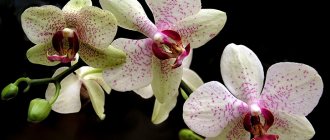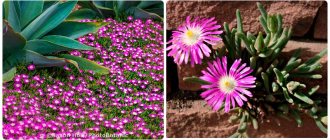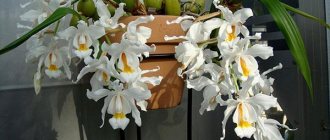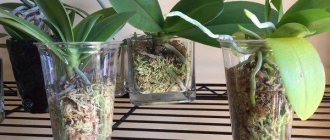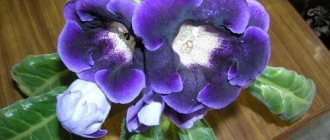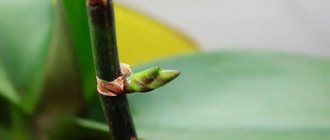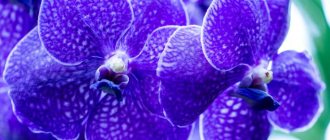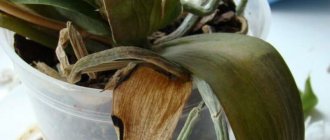The numerous family of orchids includes more than one hundred thousand species and varieties . They all differ in appearance and have different requirements for living conditions.
Let's get acquainted and find out what the Cleopatra orchid looks like, as well as a description and care for it at home.
Detailed description and photo
The Cleopatra Orchid is a fairly well-known flower among plant growers. The Latin name is Phalaenopsis hybridum, the plant was obtained through an artificial route. Cleopatra is part of the Phalaenopsis group . Two flowers can differ from each other:
- colors;
- speck shape;
- the size of the flower.
The basic colors of the orchid are white-yellow and white. Usually, after a while, shades begin to lose their brightness and saturation.
The most colorful feature is the intricate speckling. The dots can be pink, lilac or purple. Thanks to these grains an unusual pattern is created!
The plant is 60 to 70 centimeters tall. It has 3-7 leaves of bright green color, the length of which is 10-30 centimeters. These leaves are collected in a rosette, and flower stalks up to 70 centimeters long grow from the rosette. A new leaf appears at 4-8 months.
Now let's talk about Cleopatra's parts. The sepals are oval in shape and medium in size. The main color is white or slightly yellowish. There are small lilac specks along the background. The column is small, has a lilac base and upper surface, and a white beak is also present.
The petals have a round, symmetrical shape. The petals themselves are white or slightly yellowish, with many lilac specks. The diameter of the flower is no more than 7 centimeters. The lip is large, three-lobed, lilac in color with white highlights. The roots are aerial and well developed. They are grayish-green or deep green in color.
The Cleopatra orchid lives from 10 to 15 years; towards the end of its life it is renewed.
Botanical affiliation
Orchid variety Cleopatra belongs to Phalaenopsis. The origins of Cleopatra are unknown for certain. The species can be traced by the appearance of the culture. The plant is monopodial because it develops upward. Its maximum height is 30 cm. The leaf blades are large, fleshy, oval in shape, as a rule, they are raised in relation to the trunk by 45°. The male nodes of the crop are shortened, and the leaves are arranged in two rows. Like other Phalaenopsis, Cleopatra is unpretentious in care and is suitable for breeding at home.
How is it different from other types?
- The plant has a long flowering period. This is considered the most important distinguishing feature.
- The flower has a rather rare color. Because of this, Cleopatra is quite difficult to find in a flower shop.
- The Cleopatra Orchid has a distinct originality. It is impossible to find 2 flowers that are completely the same. Each has its own “zest”.
You can often see people discussing the subspecies of the Cleopatra Butterfly orchid. In simple words, a Cleopatra butterfly is an orchid with incorrectly developed petals . This may be due to various reasons:
- Genetic mutations.
- Special conditions of detention.
Flower growers in this regard are divided into 2 groups:
- The first group considers this defect attractive and even some are willing to pay 2 times more for such a plant.
- The second group is categorically against such changes.
Phalaenopsis Cleopatra (Cleopatra) 2 stv
Phalaenopsis is native to the dense tropical forests of southern Asia (southern India, Taiwan and the Philippines), New Guinea and Australia. This biological species has up to seventy varieties, in addition, there are thousands more different hybrids and varieties. These are plants with greatly shortened stems.
The leaves are evergreen, 10-30 cm long, collected in a rosette from which flower stalks and aerial roots grow. For its color and shape of the petals, similar to the fluttering wings of a butterfly, this flower was called “orchid-moth” or “orchid-butterfly”.
You can find phalaenopsis with a single flower, as well as with many inflorescences that fit on one stem. The stem can reach a length of sixty centimeters and bear up to twenty inflorescences.
Phalaenopsis is the most unpretentious plant of the orchid family, and for beginners it is recommended to breed orchids from it.
Thanks to its lush and frequent flowering and excellent adaptation to indoor conditions, this plant has become the most popular of the genus of orchids grown indoors. Before purchasing, carefully inspect the plant: the roots should be green and silver.
Characteristics
Flower color: multicolor Flowering period: once every six months Flowering duration: 8 weeks Maximum height: 70 cm.
Premises requirements
Lighting is bright, humidity is average, temperature in summer is +25+30C, in winter +18+25C.
Phalaenopsis needs an influx of fresh air, but it is important that there is no draft. Almost all species feel comfortable during the day from +22 to +30C, at night not lower than +16. Drafts and excessive heat are dangerous for the plant.
Cooler temperatures promote flowering, hotter temperatures promote the appearance of flowers on the peduncle. Phalaenopsis love bright light, and if there is no sun, you can use artificial light (fluorescent lamps).
Do not place the orchid in direct sunlight (burns are possible). At temperatures above +35° C, the orchid must be placed in a cooler place, and the roots and foliage should be sprayed with warm water.
Phalaenopsis requires bright light for at least 12 hours in winter. With insufficient lighting, flower growth slows down, and in winter the orchid may go into a dormant state.
For additional illumination, fluorescent lamps emitting a white glow are used. However, if you do not have the opportunity to additionally highlight the flower, nothing bad will happen.
Your orchid will actively develop in the spring-summer period and rest with the onset of winter.
In order for your orchid to bloom, a number of conditions must be met:
- move the flower pot as little as possible;
- do not allow sudden changes in temperature;
- provide the plant with sufficient light;
- Monitor the air humidity in the room.
You need to water with filtered, boiled or settled water, abundantly (by immersion), but rarely (in the summer once every 4 days, in the winter once every 7). Wait for the water to drain, remember that overfilling is much worse than underfilling. Irrigation water should not get into the growing point (the center of leaf growth) to avoid rotting.
Mostly mineral fertilizers with a certain level of acidity are suitable for phalaenopsis. Typically, fertilizers for orchids contain much less microelements than for ordinary indoor plants.
When choosing fertilizer, preference is given to liquid forms, as it will save you from the need to weigh and measure proportions.
In addition, pay attention to the presence of special ingredients that prevent the accumulation of excess salts.
Remember that for a healthy plant, the root type of feeding is preferable. For a plant with a damaged or practically absent root system, spraying can be carried out.
Transplantation is carried out mainly in the spring. In addition, the plant may need a new home immediately after purchase. For transplantation, you can buy a ready-made substrate. The orchid must be removed from the pot and the root system must be cleaned of the substrate.
Then you need to inspect the flower, remove yellowed leaves and rotten roots, treat the cuts with an antiseptic and dry the flower. It's best to let it sit overnight. The next day you can start transplanting.
To do this, take a new pot, place drainage in the form of expanded clay at the bottom, place the orchid in the center of the container and cover it with prepared bark. There is no need to fall asleep too much, remember that the roots need access to oxygen.
Reproduction of phalaenopsis at home is quite problematic. Often the formation of children on the mother's peduncle, which are then transplanted into the prepared substrate.
Among orchids, the most common diseases are those caused by improper care. In addition, phalaenopsis is very susceptible to rot, powdery mildew and fungi. The most commonly observed pests are mealybugs and citrus bugs.
Source: //orchidea-shop.ru/katalog/dekorativnyie-tsvetyi/orhideynyie/falenopsisyi/falenopsis-kleopatra-Cleopatra-2-stv
Bloom
The Cleopatra orchid can bring pleasure to its owner at any time of the year, and especially from January to June. There are approximately 10 pieces in an inflorescence. The flowers last quite a long time, up to 6 months. While the lowest flowers fall off, new ones begin to bloom at the top. There is no need to cut off the peduncle after flowering.
For flowering, the plant requires a difference in day and night temperatures, as well as a period of rest.
If your orchid does not bloom, then you can help it with this. You need to put the pot with Cleopatra in a cool room (about 15 degrees) for 1-2 months. After this everything will be fine.
Also, during the flowering period, it is advisable to spray the flower with microfertilizers , which contain manganese, molybdenum, boron, vitamins and other useful substances.
Description of the flower
The orchid blooms at any time of the year, but more often from January to June. The variety is characterized by a long, wave-like flowering period with dormant breaks. This type of phalaenopsis belongs to multiflora - orchids, in which multi-flowered racemose inflorescences are formed at the ends of the flower arrows.
The decorative variety Cleopatra has the following characteristics:
- The inflorescence contains 10 round buds with a diameter of 5–8 cm.
- An orchid has only one color.
- The petals are regularly rounded, white or cream in color, speckled with purple.
- The sepals are medium-sized and match the color of the petals, with small lilac splashes.
- The three-lobed lip is large in size, lilac in color with white highlights.
The plant may have buds with irregularly shaped petals called peloric.
This mutation is appreciated by Cleopatra lovers, but the next flowering may be ordinary.
How much does an adult plant cost in the store? Where can I buy it?
On average, the cost of a good adult plant is from 700 rubles. up to 2000 rub . The price may depend on:
- Plant color. As a rule, it all depends on the rarity of the color.
- Number of peduncles. The more flower stalks, the higher the cost.
- The country from which the orchid was brought. The more prestigious the country, the more expensive the flower.
You can buy a Cleopatra orchid online or look for it in flower shops in the city. But, as practice has shown, it is recommended to buy attractive and well-groomed flowers through online stores.
Reviews
Alina. “I recently went to a flower shop and decided to buy an orchid for my friend’s birthday. I chose the most beautiful flower. The saleswoman said that it was called Cleopatra and these were rarely on sale. The birthday girl liked the gift. It’s already been a month and it’s still blooming.”
Olga. “I have long wanted to buy Cleopatra. On the forum everyone just talks about her, they post beautiful pictures. I found out from one forum member who she bought the plant from. I had to wait a month - the shipment of flowers took a long time to travel from Holland to the seller. I received the orchid by mail and only unpacked it at home. I saw it and gasped, it’s even better in real life than in the photographs. I placed the flower in the most visible place - on the window in the kitchen. There are 6 phalaenopsis in my collection, this one is my favorite.”
Oksana. “I’m indifferent to indoor flowers. There are a couple of plants at home, but I don’t even know what they are called. And then I was in the shopping center, saw an amazing beauty, and bought it. A friend, a plant lover, said it was Phalaenopsis Cleopatra. Now I’m learning how to care for him.”
What kind of soil is needed?
The substrate is a special bark with pieces of charcoal and sphagnum . It can be bought at flower shops, just like pots.
You can also make your own soil mixture. Need to combine:
- peat;
- pieces of pine bark;
- moss;
- charcoal.
We wrote about whether an orchid needs drainage here.
Signs associated with flowers
The mysterious has always given rise to superstitions and legends. The orchid as a very unusual flower has not escaped speculation. The negative sign that an orchid is an energy vampire is most likely due to the fact that the plant lives on a tree. It is believed that it will also “drink the juices” from those who live in the house. But it is important to know that the orchid uses trees only as a support, not parasitizing on them, but receiving moisture and nutrients from the air and rain. There is another superstition that this plant drives a man out of the house.
For those for whom it is important to believe signs, we can advise you to exclude the interaction of a man and an orchid.
There is also positive news: if the orchid is well-groomed, healthy and blooms generously, it will bring happiness to the house, and to its owner - beauty, youth, new hidden talents and opportunities. The main thing is to prevent diseases of your home flower. The plant acts as a protector of the home: if a person visiting is unpleasant to you, then the flower will direct energy to ensure that he leaves as soon as possible. Flowers of different colors are credited with having a certain influence on people. Cleopatra, as the bearer of white and pink shades, treats blues and depression.
Landing
You need to prepare all the necessary materials in advance. The pot should be transparent and have drainage holes on the sides . It is also recommended to take a pot that is neither deep nor narrow. This is done to ensure that the roots have access to light and oxygen.
The roots should be disinfected with a nutrient solution before planting.
Afterwards, the plant needs to be planted in the pot itself with soil and filled in, filling the voids. Next, water everything well and you’re done!
Home care
The flower is completely unpretentious to care for, but in order for it to please you for a long time, the following conditions must be met:
- Provide proper lighting . It is strictly forbidden for the orchid to be exposed to direct sunlight, as this may cause burns on the petals.
- Observe the temperature regime . During the day – +20-24 degrees, and at night – +18 degrees. The plant really does not like sudden changes in temperature.
- Ventilation of the room . It is worth ventilating the room 1-2 times a day, but there should be no drafts.
- High air humidity – at least 70-80%. In hot weather, it is recommended to spray the plant with soft water at room temperature.
- Regular watering . The orchid needs to be watered 1-2 times a month. In hot weather, watering is increased. Water for irrigation should be soft, settled and at room temperature.
- Feeding . Special fertilizers for orchids can be found in flower shops.
Conditions of detention
The optimal temperature for growing Cleopatra is from 14°C to 24°C.
A suitable place for this orchid is a bright, but not hot, windowsill. In winter it could be :
- Eastern;
- Western;
- And even a south window.
To ensure that the orchid does not die, it must be properly cared for.
In summer, direct sunlight is too hot, this can lead to burns of the leaves, so the flower must be shaded.
to water in the morning :
- In summer, in extreme heat - twice a week;
- And in winter - about once a week.
A very convenient way of watering is to immerse the Cleopatra pot in water for 10 minutes so that all the bark is under water.
Then they take out the plant, let the water drain and put the flower in place. Cleopatra will appreciate it if you spray it while watering . It is convenient to do this in the bathroom, giving the flower a warm shower. A few minutes of this procedure is enough.
After this, be sure to remove water from the center of the outlet so as not to cause it to rot. They do this with a regular paper napkin, carefully blotting the leaves from excess moisture.
The plant is fed with special fertilizers for orchids , always on a moist substrate. It should be remembered that the flower does not like an excess of nutrients; fertilizing is carried out in accordance with the instructions. It is better to underfeed than to overfeed Cleopatra.
Important! Some bacteria cause root rot, and the presence of parasitic fungi can lead to spots on the orchid. As a preventive measure, drafts and waterlogging should be avoided. Make sure that water does not stagnate in the center of the flower rosette after watering.
Large flower stalks of phalaenopsis need support . The plant is tied to it in several places to maintain balance.
Transfer
The Cleopatra orchid is replanted once every 2-3 years. The most suitable time period is spring or early summer. It is not recommended to replant during the flowering period.
How to transplant:
- Carefully remove the root orchid from the container.
- Trim off the rotten roots and sprinkle with crushed coal.
- Prepare the pot. Place drainage at the bottom and cover it with soil.
- Plant a plant there and cover it with soil.
That's the whole scheme. Watering is not carried out immediately, but several days after transplantation.
Contents of the Cleopatra orchid and principles of care
Phalaenopsis Cleopatra is attractive not only for its spectacular coloring, but also for its low maintenance. This is a fairly unpretentious plant that can grow and bloom even in the back of a room.
And yet, gross violations of the principles of care will greatly affect the quality of flowering and the health of even this non-capricious orchid . Therefore, it is important to create more or less acceptable conditions of detention for Cleopatra:
| Condition | Description |
| Light | Preferably placed on east or west windows. The variety can also grow in northern areas, but in winter additional lighting is desirable. When placed in the back of the room, it is also better to supplement artificial lighting with a phytolamp. |
| Air temperature | The optimal range is from +200С to +260С. For better flowering, small differences between day and night temperatures are desirable. |
| Substrate | The best option is to grow in hanging baskets without substrate. When growing in pots, the container should be filled with materials that do not retain water, dry quickly, and allow air to pass through well. |
| Humidity | Air humidity should be maintained moderate. At high temperatures it can be about 80-85%, but in winter and autumn it should be reduced to 70%. The substrate humidity should be low. Periodic long drying is recommended, especially between waves of flowering. |
Feeding the Cleopatra orchid does not have any special features and is carried out in the same way as feeding other phalaenopsis. During periods of new leaf growth and root growth, this variety requires complete mineral fertilizers, balanced in nitrogen, phosphorus and potassium. During flowering, spraying with microfertilizers containing boron, manganese, molybdenum and other trace elements, as well as vitamins and amino acids, is useful.
Important! Sphagnum moss, popular among orchid lovers, should not be used as a pot filler for Cleopatra. Even in small quantities, it often provokes rotting of the orchid root system.
Cleopatra's roots need a lot of air. Therefore, having bought this orchid, you need to make additional holes in the walls of the pot. It is convenient to do this with a hot nail head.
How does Cleopatra reproduce?
The Cleopatra orchid is propagated in 2 ways:
- Vegetative method . We need to wait until the babies appear on the flower stalks. After they have produced roots, they are carefully separated from the mother plant and planted in individual small containers.
- Seed method . This method is difficult to implement at home. Initially, what needs to be done is to perform artificial pollination. Next, wait 8-9 months for the seeds to ripen. Then the seeds are collected and a special medium is prepared in which the seeds are germinated and for several months the seedlings grow in sealed flasks.
Features of care
The health, decorativeness of this flower and the duration of flowering depend on how correctly and on time it is given the necessary care.
Feeding
Proper and balanced nutrition will ensure high immunity against diseases and high-quality flowering.
| Term | Type of feeding | Proportions | Submission rules | Action |
| During the active growing season | Mister-Color all-rounder with high nitrogen content | According to instructions | Every two weeks | Stimulates the growth of flower shoots, leaves, root systems and children. You can also use this fertilizer when replanting purchased plants and in the process of planting young orthos. |
| During the period of bud formation and flowering | Mister-color orchid, contains a high percentage of phosphorus and potassium | According to instructions | Every 10 days | Stimulates lush and long-lasting flowering |
Before applying fertilizing, watering is carried out and the leaves are irrigated to prevent them from burning.
Fertilize the flower in a room where there is no scorching sunlight, otherwise it may burn, turn yellow and die.
Trimming scheme
This procedure begins after the plant has completely flowered. The shoot is cut just above the two lowest buds. The cut areas are sprinkled with charcoal. For quick recovery, you can spray with Epin or Heteroauxin.
Watering
The amount of watering depends on the time of year
The frequency of watering depends on the time of year:
- in summer, the root system is saturated through a tray or by deepening the flowerpot into a container with water once every seven days;
- In autumn and winter, moisture is reduced to once every 3-4 weeks.
The plant is placed in a bucket of water at room temperature for 15-20 minutes.
If the orchid has entered the resting phase, it does not need to be watered for 1-1.5 months, otherwise it will become more active and begin to grow green mass.
Additionally, they carry out sanitary cleaning of the leaves - wipe them with a cotton pad soaked in water. This helps maintain the decorative appearance of the flower and prevents the appearance of parasites.
Transfer rules
To replant a purchased orchid or a house plant that has become cramped in an old flowerpot, use a store-bought substrate or a mixture prepared independently according to the recipe presented above.
- A newly acquired flower is replanted 20 days after quarantine.
- For domestic specimens, this procedure is carried out every three years. This is usually done in late spring or early summer.
Choose a container slightly larger than the volume of the root mass so that new roots can develop.
You should not touch purchased flowering plants until they drop their buds, otherwise you will ruin them.
There are a few exceptions in emergency cases:
- mass wilting and falling leaves;
- significant damage by pests and diseases;
- rotting of the root system or aerial parts;
- the flower suffers from lack of space;
- the appearance of plaque or spots on the peduncle, leaves or inflorescences.
The transplantation technique is simple - the plant is removed from the pot and the roots are carefully examined. All rotten, blackened parts are cut off, dusted with cinnamon powder, and transplanted into a container filled with substrate.
Watering the transplanted flower is allowed only after 3-4 days. During this time, the wounds will have time to heal.
Diseases and pests
Due to improper maintenance, Cleopatra may develop various diseases:
- Yellowing . Often the culprits of such a disease are pests. The flower should be disinfected with Fitoverm or another insecticide.
- Fungal disease . The result may be rotting of parts of the plant. Damaged parts are trimmed and treated with Fundazol.
- Sunburn is not a disease, but this exposure also damages the orchid.
Frequent mistakes of flower growers
Lack of flowering is one of the most common problems caused by a lack or excess of nutrients, frequent waterlogging or poor lighting. Therefore, you should strictly adhere to the dosage of fertilizing, keep it on a well-lit windowsill and follow the watering schedule.
Transplanting into a pot that is too large is the second reason why an orchid does not bloom. You need to take a container with a volume 1/3 larger than the previous one.
Drastic trimming of flower stalks is one of the main mistakes of beginners. The plant not only stops blooming, but also dies over time. Follow the procedure described above.
Keeping in a draft or in a room where there are sudden temperature changes. In such a place, the flower sheds its buds en masse, begins to wither, and if a stable temperature regime is not created for it, it may die.

